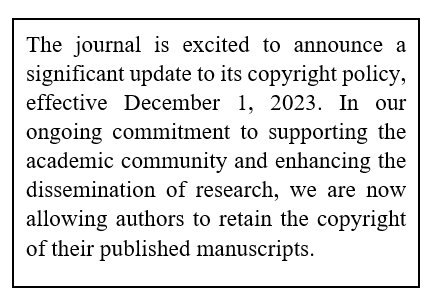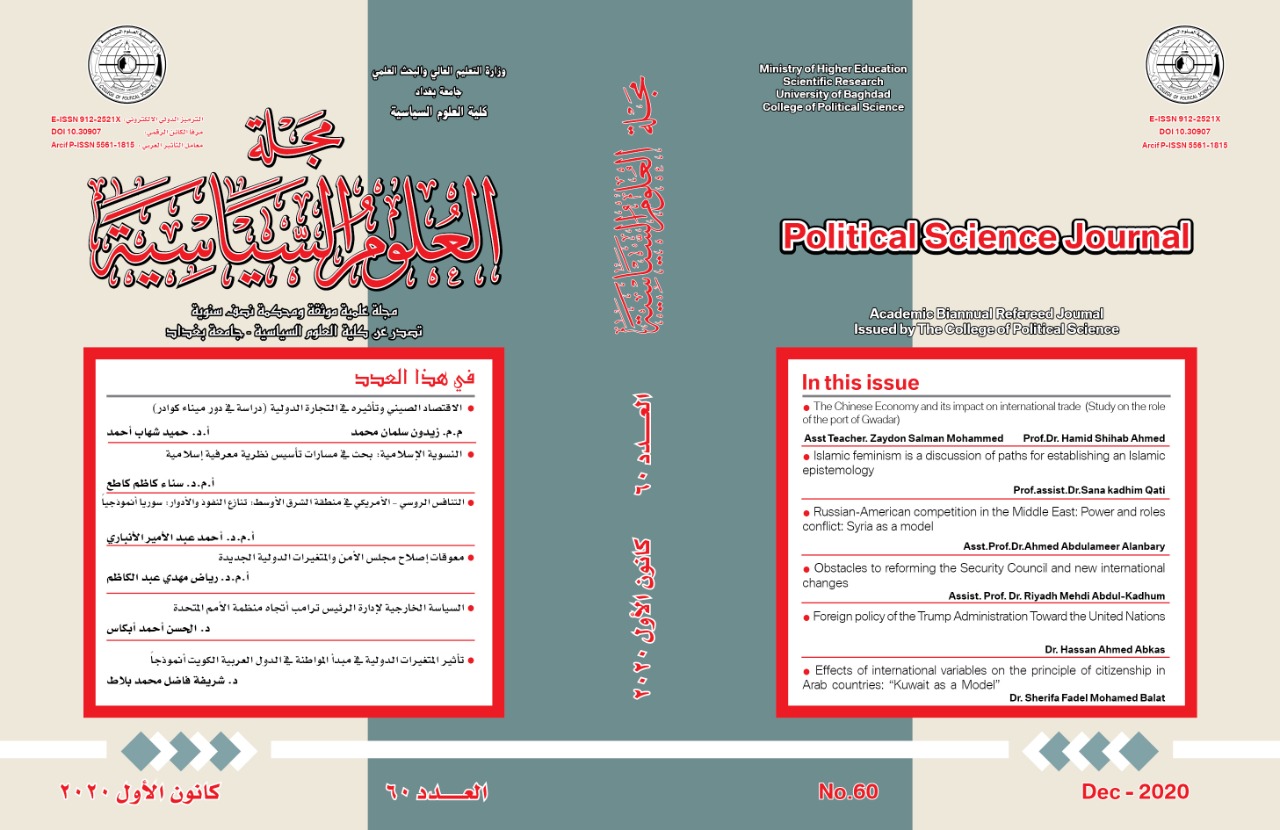
Guidelines for Authors
Publishing Instructions
These instructions contain three sections, namely: (Rules of Publishing, writing references, instructions for authors), and as below:
Rules of Publishing
Political Sciences Journal is a biannual academic journal pioneered in Political Science. It is considered one of the first academic journals in the Arab region and a distinguished scientific platform for scholars and researchers. It publishes all research and academic studies covering the latest updates and contemporary developments in academic research, specializing in political science. It also enriches human knowledge by achieving the value of knowledge for researchers.
The Journal is issued by the College of Political Science /University of Baghdad. It publishes according to the following requirements:
- The submitted research to the Journal must be authentic and add a knowledgeable and theoretical value to the specialization that enriches academic and objective scientific discussions.
- The submitted research must be unpublished before and not submitted for assessment and publication in other journals or other languages.
- The submitted research must be free from plagiarism (Plagiarism checks), and the research that contains inadequate and misleading facts will be rejected.
- The submitted research must be written in English or Arabic, and its words must not exceed 8000 words.
- Submitted research must be written in the MS Word program; research typed on tabs will be rejected. The font of writing is (Times New Roman) for English text and (Simplified Arabic) for Arabic text, size 14, bold, and single space. Headings must be bold and size 16. Quotations must be size 12, and margins must be at least 0.5 cm.
- Research papers should be printed on A4 paper, with normal footnotes.
The manuscript must be arranged as follows:
Manuscript organization
Authors have the flexibility to arrange their research as they find properly, but they must clearly organize the manuscript into sections as follows:
- Title
- List of authors, their affiliations, and email addresses
- Abstract
- Keywords
- Introduction
- Methodology
- Body of manuscript
- Conclusion
- References
----------------------------------------------------------------------------------------------------
The first page includes:
A. the Title
- It should be in Arabic and English in the middle of the page.
-The title should be concise.
-It should not be more than 12 words long.
-Avoid abbreviations and formulas wherever possible.
B. Author information
Name(s) of the author(s).
- Affiliation(s) of the author(s), i.e., institution.
- Active email address of the corresponding author and phone number
- The ORCID link for the author(s)
The second page includes:
A. Abstract
The abstract is presented in short, precise, and clear sentences, in which the main argument is indicated, the scientific approach used in the research, and the most prominent conclusions, in both Arabic and English, each 200-250 words.
B. Keywords
-Keywords are written in both Arabic and English
-The author must provide 4 to 6 keywords that can be used for indexing purposes.
The third page:the research starts from the third page upwards, which includes:
A. Introduction
- This section should be brief, including the background, importance, objective of the research, and a description of the gap in knowledge that the research is designed to fill, which includes the problem statement or question.
- The research hypothesis is placed within the text of the introduction; usually, it is only one sentence. For example, a research hypothesis about the behavior patterns of political leaders could be as follows: "It was predicted that political leaders with management experience have more flexible behavior than their counterparts with only political experience."
- Avoid a detailed literature survey or a summary of the results when preparing the introduction.
B. methodology
- This section should contain detailed information about the procedures and steps involved in the study. It can be divided into subsections if several methods are utilized.
- Data and Reproducibility
The Political Sciences Journal encourages authors to include statistical tables, datasets, or appendices that support their findings, or to reference repositories or sources where such data are available. If the data cannot be made publicly available due to confidentiality, proprietary rights, or ethical considerations, this should be clearly stated in the “Author Notes” or “Methodology” section.
- Ethical Oversight
Authors must clarify whether their research involving individuals, personal data, or vulnerable groups has obtained the necessary consent to publication and ethical approvals from the relevant authorities or institutions. Authors must also ensure the protection of participants’ privacy and the confidentiality of any sensitive data.
C. body structure
The body of the study should be divided into specific sections (main and sub) classified in a sequential manner, as appropriate, which includes:
- Summarize key relevant studies, categorizing approaches, variables of interest, and key findings, as well as the gaps in previous research to be addressed in the research.
- Experimental and/or descriptive details of the research.
- Results and Discussions: Results and discussions contain the results obtained by the author during research activities. That is, what the author found objectively, without speculating on why you found these results. the research results are presented in advance as a whole. then the discussion interprets the meaning of the results, puts them in context, and explains why they matter.
The discussions are presented systematically from the general to the specific. Data can be presented in tables or forms, if any. Results and discussions should relate to the theory used. Avoid excessive use of citations and discussion of published literature.
D. Conclusion
The author should clearly explain the research's significant conclusions, highlighting their importance and direct relevance to the topic.
E. References
The journal uses the Chicago style 16th in referring to a source of information (In-Text Citations) and in writing the list of references at the end of the research, in (Times New Roman) font size 12.
Writing references
The journal uses the Chicago style 16th in referring to a source of information (In-Text Citations), and in writing the list of references at the end of the research, in (Times New Roman) font size 12.
To see examples of Chicago-style citations in Arabic, visit the link below
https://jcopolicy.uobaghdad.edu.iq/index.php/jcopolicy/libraryFiles/downloadPublic/21
To see examples of Chicago-style citations in English, visit the link below
https://jcopolicy.uobaghdad.edu.iq/index.php/jcopolicy/libraryFiles/downloadPublic/6
Instructions for authors
- The manuscript must be submitted to the journal's website using the submission system.
- When the research is received, the Journal will notify the researcher of receiving it during five days of work.
- The manuscript is subject to the (Turnitin) plagiarism detection software before sending it to reviewers, preferably the authors conducting linguistic reviews in Arabic and English.
- The referenced facts adopted in the manuscript should not be taken from arbitrary Internet sites but only those that rely on research published in international or local journals, books, dissertations, and thesis.
- The research undertaking and submission request forms (available in the Author Guidelines section) should be completed formally and submitted before any action is taken by the journal.
- The author must incorporate revisions required by reviewers within a maximum period of one month; however, the author should view and approve the final copy of the manuscript within three days.
- The researcher will be notified of rejecting or accepting the research over a time span of 2-3 months. Upon acceptance, the researcher will be notified of the publication date and provided with an acceptance letter.
- Political Sciences Journal applies the license of CC BY (a Creative Commons Attribution 4.0 International License). If you need more information on this license, please follow this link:
https://creativecommons.org/licenses/by/4.0/
The journal applies the license of CC BY (a Creative Commons Attribution 4.0 International license). This license allows authors to keep ownership of the copyright of their papers. however, this license permits any user to download, print out, extract, reuse, archive, and distribute the article, so long as appropriate credit is given to the authors and the source of the work. The license ensures the study will be available as widely as possible and can be included in any scientific archive.
- Publishing fees from outside Iraq ($100) US dollars, and from the inside (145,000) thousand Iraqi dinars.
- Exemption from fees of publishing for researchers from developing countries.
- If the researcher does not abide by the instructions of publication, it will lead to delay or non-publication of the submitted research.

 ©️ 2023 The Author(s). Published by College of Political Science, University of Baghdad. This is an Open Access article distributed under the terms of the
©️ 2023 The Author(s). Published by College of Political Science, University of Baghdad. This is an Open Access article distributed under the terms of the 












